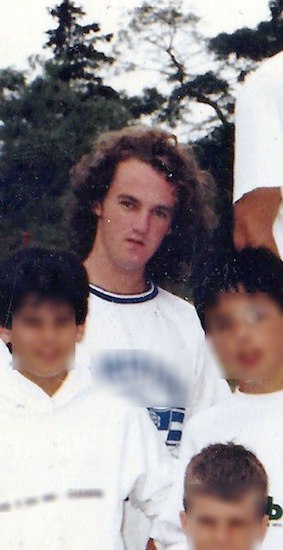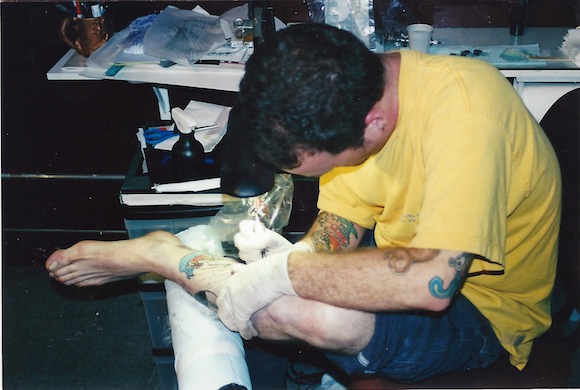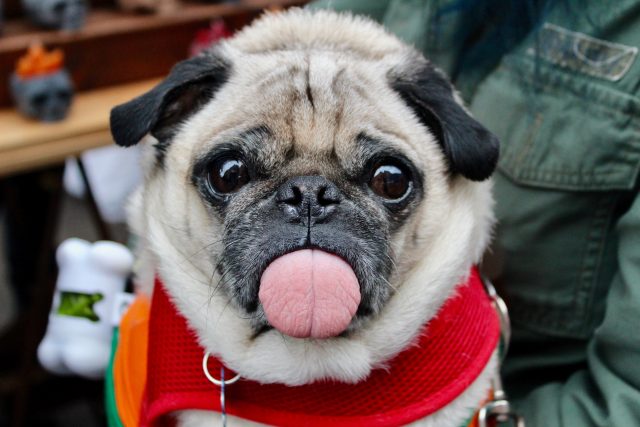
At Brokelyn we’re familiar with the concept of being starving artists, and the years of unpaid gigs and dedication required to “make it.” Adam Suerte, co-owner of Brooklyn Tattoo and founder of the artist collective, Urban Folk Art® Studios, knows everything there is to know about that life. From his beginnings as a teenage graffiti artist in Brooklyn, Suerte has cultivated his art form over the years and now co-owns one of Brooklyn’s most successful tattoo studios, Brooklyn Tattoo, and next door’s Urban Folk Art gallery, which exhibits art from a range of emerging and established artists, across various mediums. Before he was a tattoo master though, Suerte spent time as a camp counselor, a dishwasher, a struggling screenprinter and a fruit basket delivery boy until finally opening his own shop. – MB

1. Camp Counselor, Cape Cod, Summers 1988-1989
I went to camp in Cape Cod during the summers in high school because after I started writing graffiti, my mother wanted me out of the city to keep me out of trouble. The camp was pretty stuffy. I had longer hair than most of the girls there, and me and my friend who joined me stuck out like sore thumbs. I graduated being a junior counselor the summer after graduating from high school, so the following summer I became a fully-paid counselor. I loved working with the kids and even got my certification to teach swimming.
The camp was very anti-graffiti, (their version was kids writing on the ceilings of the bunks, and in the archery bus), but I still put a couple black books of my graffiti on display at an art show once. I overheard the woodworking teacher mumble “That shit should be displayed in the bathroom.” The upper staff wasn’t into the likes of me. Sure, my friend and I smoked weed and whatnot, but there were some clean-cut motherfuckers tripping on acid and doing coke during the day and never got a second glance. We never got caught doing anything, but they had their suspicions.
Most of the staff were college students, the fratty drinking kind, so on our nights off, the drinking was heavy. I had a fake ID I got from Butterfly on 8th street in the Village but when it didn’t work we had to ask the older counselors to buy us booze. After the second summer I wasn’t having fun anymore, and they suggested I take a summer off. I never went back.
2. Dishwasher, Rhode Island School of Design, Providence, 1988-1991
The Refectory was where all of the students at the Rhode Island School of Design ate meals. Freshman year, I’d laugh wondering why other students would bother working behind the conveyor belt in the dish room, grabbing the trays full of garbage. However, sophomore year I was broke, so there I was in the dish room, where I worked through senior year. I was responsible for catching the trays as they came down the conveyor belt; one of us got the glasses and silverware, another of us got the small dishes, saucers, and coffee mugs, and the last two guys grabbed the big plates and trays, dumping the food into the industrial garbage disposal and stacking them.
It actually became fun; there was a lot of camaraderie back there, and an odd sense of pride. It was a job that could definitely be done hungover; the shifts weren’t more than a couple of hours and we ate for free, which was a double bonus (despite the mediocre food). Students registered their opinions of the food by spelling out mean things with their leftovers, mixing up the refuse with their liquids or shouting down the conveyor belt tunnel how much their meal sucked (as if the dishwashers had anything to do with that). My senior thesis for my BFA in Illustration was a series of scratchboard drawings of me and my co-workers in the dish room.
3. Restaurant dishwasher, East Providence, 1989-1990
With my vast experience washing dishes at school, I landed a job at a local East Providence restaurant. It was far away from where I lived, but I skateboarded back and forth. These shifts were long, the dishwashing area really small, and it also required me to make garlic bread and salads. The food was much better though, they allowed us to drink as the night wore on, and we smoked weed in the walk-in outside. The cooks prided themselves on their DUIs and I got a good look at the culture of restaurant work.
4. College Pro Painter, Providence, Summer 1990
College Pro was a house painting company run by college students. We were picked-up and driven to wealthier places in Newport, where we made very little money to paint huge houses, beach houses, historic storefronts, etc. with minimal training. Bonuses if we finished before the estimated job time. We got yelled at by local house painters passing by in their trucks, or accosted at fast food joints while eating lunch because we were taking the jobs from these painting “lifers” (our bosses were undercutting bids). They hated us. One day we realized while on a job that we were using toxic paint without being given any breathing apparatus and when we bitched about it they gave us cotton masks. At that point we just didn’t want to do it anymore, so a few of us quit en masse, using the hazardous conditions as an excuse.
_______________________________

5. Screen Printer, Urban Folk Art®, Brooklyn, 1991-1998
I founded the artist collective Urban Folk Art®, in my good ol’ hometown of Brooklyn, with some friends from school after graduating and did many things as a collective (art shows, guerrilla art, self-published underground comics, art openings, etc). As a way to support ourselves and our artistic endeavors we set up a silkscreen studio. We lived in a loft in Bushwick that was 2,700 square feet for $1,250 (this was 1991, mind you, long before what Bushwick has become)! Four of us lived there with a darkroom and all the silkscreen equipment we’d need for t-shirt, sticker and paper printing. Our shirts were cheap, and we printed mainly for artists, musicians (lots of punk rock bands) and non-profits. We had our own line of shirts as well that sold in a few places in the city (Union, Patricia Fields, 99X).
None of us drove so we delivered shirts by subway. I could carry four dozen shirts in each hand, resting every corner. After four years in Bushwick, we all moved into separate apartments and moved the silkscreen shop to Williamsburg in the Tung Fa Noodle factory building on South 5th and Berry. We continued to print for clients for a few more years, then put the silkscreen aspect of the collective to rest.
6. Pen Screen Printer, Brooklyn, 1991
When the silkscreen aspect of the collective wasn’t supporting us as we had hoped, we all got “real jobs” (at this point, still continuing the silk screening as a side gig). I found a job at a place by the Brooklyn Navy Yard that silk screened logos on pens. It was run by an old Hasidic dude whose daughters worked the phones in the office. They weren’t allowed to look at or speak to us.
The printing machines were conveyor tracks that the pens traveled down; a tiny silkscreen and squeegee automatically printed each pen. Then the pen went under a heater and fell into the box of finished pens. I worked with a Jamaican dude who wasn’t allowed to touch the machines (he sorted and boxed stuff), and a Polish dude who was the “money pen guy.” The money pens were filled with shredded money. It got all over the place so he had to do it in a separate room, stuffing the shredded cash into the see-through pens. He emerged from the room at the end of the day with shredded money glued all over him. I didn’t last long there because I kept fucking things up. I didn’t get fired (the boss didn’t really care about the quality); it was more that I was disappointed in myself for not getting the hang of it.
7. Manhattan Fruitier (pronounced “Fruit-E-Yay”), New York, 1991-1999
I started as a delivery guy: riding shotgun in the van, getting a signature from the doorman or bringing the basket up to where it was being delivered. We were the lowest of the low, finally someone a doorman or mailroom guy could shit on! I did that for the Thanksgiving/Christmas holiday season and was called back for a few other holidays before I was asked to stay on full-time as the company grew. When not in the van I was “netting” baskets (tying the fishing netting to the baskets, they use fishing netting so the flowers and fruit pop out of it). This was not easy; at their peak during the Christmas season, they were turning out over 400 baskets a day, all of which needed to be netted, ribboned, and have cards attached.
After awhile I became the “dry fruit guy,” assembling the dry fruit boxes by individually packaging the dozens of dried fruit items, packing them in the boxes, even wood-burning the logo onto the boxes. Later I switched to doing all the shipping, while still doing any odd assortment of menial tasks when there was a lull. I was able to get a bunch of friends jobs there (at one point or another everyone in Urban Folk Art® worked at the Fruitier). It was a really great place to work with down-to-earth management. Martha Stewart had the shop on her show; Saturday Night Live had an account and every Saturday the guest star got a basket; Whoopie Goldberg came in to shop; Gregory Peck called to say how much he loved the dry fruit box he received.
_______________________________

8. Tattoo Apprentice, All Souls, New York, 1999-2000
While running the silk screening in my spare time, one of my clients was a tattooer. I printed stickers and shirts for him, and in return he tattooed me. He worked for someone out of a shop in Chelsea. It was underground, as tattooing was illegal in NY until 1997. Once it became legal, he opened his own street shop, All Souls on 103rd and Broadway, and asked me if I wanted to apprentice under him. You don’t ever get asked to apprentice in tattooing; you beg and beg and ask a million people before you are taken on, so I felt I had to accept.
I’d never wanted to become a tattooer, but said “what the fuck.” April 2, 1999 was the first day of business, and the first day of my tattoo career. The apprenticeship meant working for free full-time in exchange for knowledge. I cleaned up the shop and toilets and sterilized equipment before everyone got there in the morning. I answered the phone, talked to prospective clients, ran errands, got food for artists. I was shop bitch, working the first 30 days in a row, and it was months before I was allowed to touch a machine. During this time, learning under two Dominicans and two Puerto Ricans, I was renamed “Suerte” because our clients were less likely to trust a gringo with their tattoos.
When the year was up, I was a full-fledged tattooer with a couple dozen tattoos under my belt. I worked at All Souls until they lost their lease a year later. The partnership of the two owners deteriorated, and one of them moved the shop to Boerum Hill near where I was living. I worked there for a year when the owner announced he was moving to England and gave us the choice to buy all the equipment and becoming our own bosses. That day 14 years ago, Brooklyn Tattoo was born. It’s nothing I ever thought I’d get into, but I wouldn’t have it any other way.
9. Tattoo shop owner, Brooklyn Tattoo, Boerum Hill, 2000 – 2014
At first it was just my partner and I and the occasional apprentice or guest artist. We didn’t even have a computer the first couple of years. 14 years later we’ve built a staff of 8, and are in a space 5 times the size of the original shop in a better location than where we started. I never expected (or wanted for that matter) to be the boss of anyone, all I ever wanted was to make a living by drawing, I had no idea it would manifest itself like this.
One of the most attractive things about tattooing is that no day is identical to the other. Different things happen every day, different tattoos, different people. It’s a lot like a hair salon or a bar. Socializing is part of the job, which makes it that much more interesting and fun. I’m sure everyone talks about how their workplace could easily be made into a sitcom. That’s definitely true with us, hilarity is abound.
I’ve worked very hard, most my life so I can go to work dressed like I have since high school, and do every day the one thing I loved to do since I could remember, make art.
Leave a Reply



